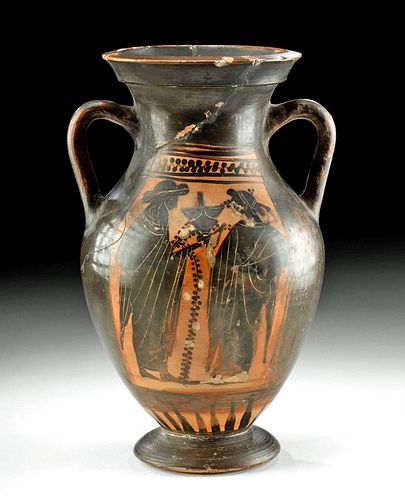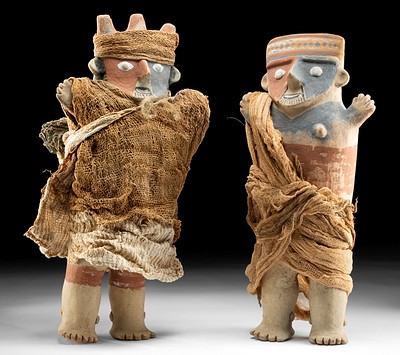Greek Attic Black-Figure Amphora, Dionysian & Battle
Lot 11
About Seller
Artemis Fine Arts
686 S Taylor Ave, Ste 106
Louisville, CO 80027
United States
Selling antiquities, ancient and ethnographic art online since 1993, Artemis Gallery specializes in Classical Antiquities (Egyptian, Greek, Roman, Near Eastern), Asian, Pre-Columbian, African / Tribal / Oceanographic art. Our extensive inventory includes pottery, stone, metal, wood, glass and textil...Read more
Categories
Estimate:
$7,000 - $10,500
Absentee vs Live bid
Two ways to bid:
- Leave a max absentee bid and the platform will bid on your behalf up to your maximum bid during the live auction.
- Bid live during the auction and your bids will be submitted real-time to the auctioneer.
Bid Increments
| Price | Bid Increment |
|---|---|
| $0 | $25 |
| $300 | $50 |
| $1,000 | $100 |
| $2,000 | $250 |
| $5,000 | $500 |
| $10,000 | $1,000 |
| $20,000 | $2,500 |
| $50,000 | $5,000 |
| $100,000 | $10,000 |
| $200,000 | $20,000 |
About Auction
By Artemis Fine Arts
May 19, 2022
Set Reminder
2022-05-19 10:00:00
2022-05-19 10:00:00
America/New_York
Bidsquare
Bidsquare : Fine Antiquities | Ethnographica | Fine Art
https://www.bidsquare.com/auctions/artemis-gallery/fine-antiquities-ethnographica-fine-art-9350
Featuring a very special collection of Fine Art from the Hollywood Hills, including Picasso & Rookwood ceramics! Also included are many fine examples of classical antiquities, ancient, and ethnographic art from cultures encompassing the globe. Artemis Fine Arts info@artemisfinearts.com
Featuring a very special collection of Fine Art from the Hollywood Hills, including Picasso & Rookwood ceramics! Also included are many fine examples of classical antiquities, ancient, and ethnographic art from cultures encompassing the globe. Artemis Fine Arts info@artemisfinearts.com
- Lot Description
Greek, Attic (Athens), ca. 480 BCE. A splendid pottery amphora adorned with black-figure decoration of a Dionysian scene on 1 side and 2 warriors on the other, both enhanced by incised details and applied beige pigment. Sitting upon a discoid foot, the elegant vessel displays a classic silhouette with an ovoid body, a sloped shoulder, an attenuated neck, twin tubular arched handles, and a flared rim. One side of the body features a bearded Dionysus - the Greek god of wine - crowned by an ivy wreath and draped in a long chiton and himation. Shown in profile, the ancient deity faces right as he converses with a maenad and holds out a kantharos with one hand, perhaps inviting his female companion to take a sip. His other hand grasps lengthy vines that meander across the scene. Conversely, the alternative side exhibits a pair of confronting, helmeted soldiers: a Scythian archer on the left and a Greek hoplite on the right. Size: 6.5" Diameter x 10" H (16.5 cm x 25.4 cm)
The Scythian thrusts his spear towards the hoplite with his right hand, while carrying a bow in his left and a quiver at his waist. Dressed in greaves, the Greek warrior grasps 2 spears and a circular shield embellished with a blazon of an anchor that he holds in front of his body. A band of zigzag motif decorates the top of both scenes, and a horizontal register of rays adorns the area just above the foot. A lustrous black pigment envelops the remaining exterior of the amphora, as well as the interior of the rim.
First appearing on pottery of the 8th century BCE, shield blazons are often featured prominently in scenes of hoplites. These symbols were sometimes intended to terrify one's opponents - such as in the case of the Gorgoneion - while, in other cases, shield blazons were connected to the owner of the shield and carried a personal import. Examples of this would be the image of a lion being used to represent the strength and courage of a warrior or a snake to symbolize wisdom and immortality. Like the hoplite in this example, Sophanes, the son of Eutychides, bravest of the Athenian fighters at Plataea (480 BCE), was said to bear the image of an anchor on his shield. In his "Histories," Herodotus wrote of Sophanes saying, "Two different stories are told about him: one, that from the belt of his breastplate he carried an iron anchor slung from a bronze chain, which he would throw whenever he drew near his enemies so that when they broke out of their position in the ranks to assault him, they would be unable to budge him; then, when his opponents were in flight, his tactic was to pick up the anchor and chase them with it. That is one of the stories; according to the other […], he did not actually wear an anchor attached to his breastplate, but instead had an anchor as an emblem on his shield, which never ceased moving and was always in swift motion."
The battle scene is starkly contrasted by the images of Dionysian delight on the other side of the amphora. Portrayals of Dionysus from this time period often show him with a full beard, as seen in this example. Later artists shifted to depicting him as a youth, with a smooth face, while his follower Silenus was shown as an older man with a full beard. The cult of Dionysus was hugely popular in the Greco-Roman world, and symbols of the god and his followers are found on many vessels, sculptures, and monuments - signifying the freedom created by wine, music, and ecstatic dance. Maenads were female followers of Dionysus and made up an important part of the god's retinue, known as the thiasus. Translating to "raving ones," the maenads were often portrayed in a state of euphoric frenzy through a combination of dancing and intoxication.
Provenance: private Wabasha, Minnesota, USA collection; ex-Nancy and Dr. E.F. Simpson collection, Los Angeles, California, USA, acquired from 1970 to 2000; ex-prominent Encino, California, USA collection
All items legal to buy/sell under U.S. Statute covering cultural patrimony Code 2600, CHAPTER 14, and are guaranteed to be as described or your money back.
A Certificate of Authenticity will accompany all winning bids.
PLEASE NOTE: Due to recent increases of shipments being seized by Australian & German customs (even for items with pre-UNESCO provenance), we will no longer ship most antiquities and ancient Chinese art to Australia & Germany. For categories of items that are acceptable to ship to Australia or Germany, please contact us directly or work with your local customs brokerage firm.
Display stands not described as included/custom in the item description are for photography purposes only and will not be included with the item upon shipping.
#171828Professionally repaired with restoration and repainting over break lines. Some minor chips to rim, handle, and along break lines. Nicks and abrasions commensurate with age. Otherwise, excellent with impressive preservation of pigments and detail. Greek letters carved on underside of foot, possibly reading "Z E."Condition
- Shipping Info
-
All shipping is handled in-house for your convenience. Your invoice from Artemis Gallery will include shipping calculation instructions. If in doubt, please inquire BEFORE bidding for estimated shipping costs for individual items.
-
- Buyer's Premium



 EUR
EUR CAD
CAD AUD
AUD GBP
GBP MXN
MXN HKD
HKD CNY
CNY MYR
MYR SEK
SEK SGD
SGD CHF
CHF THB
THB















